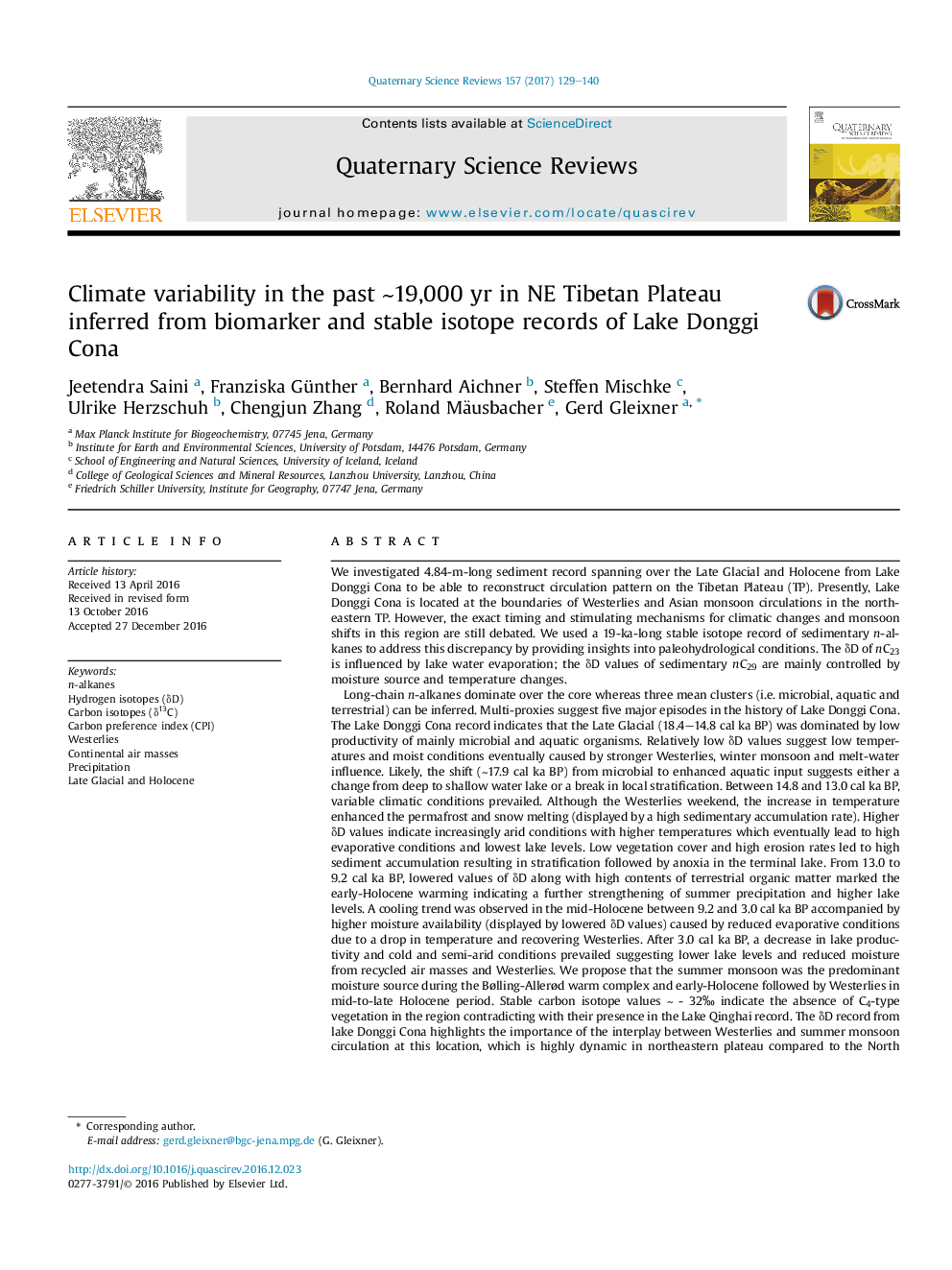| کد مقاله | کد نشریه | سال انتشار | مقاله انگلیسی | نسخه تمام متن |
|---|---|---|---|---|
| 5786860 | 1640778 | 2017 | 12 صفحه PDF | دانلود رایگان |
عنوان انگلیسی مقاله ISI
Climate variability in the past â¼19,000Â yr in NE Tibetan Plateau inferred from biomarker and stable isotope records of Lake Donggi Cona
دانلود مقاله + سفارش ترجمه
دانلود مقاله ISI انگلیسی
رایگان برای ایرانیان
موضوعات مرتبط
مهندسی و علوم پایه
علوم زمین و سیارات
زمین شناسی
پیش نمایش صفحه اول مقاله

چکیده انگلیسی
Long-chain n-alkanes dominate over the core whereas three mean clusters (i.e. microbial, aquatic and terrestrial) can be inferred. Multi-proxies suggest five major episodes in the history of Lake Donggi Cona. The Lake Donggi Cona record indicates that the Late Glacial (18.4-14.8 cal ka BP) was dominated by low productivity of mainly microbial and aquatic organisms. Relatively low δD values suggest low temperatures and moist conditions eventually caused by stronger Westerlies, winter monsoon and melt-water influence. Likely, the shift (â¼17.9 cal ka BP) from microbial to enhanced aquatic input suggests either a change from deep to shallow water lake or a break in local stratification. Between 14.8 and 13.0 cal ka BP, variable climatic conditions prevailed. Although the Westerlies weekend, the increase in temperature enhanced the permafrost and snow melting (displayed by a high sedimentary accumulation rate). Higher δD values indicate increasingly arid conditions with higher temperatures which eventually lead to high evaporative conditions and lowest lake levels. Low vegetation cover and high erosion rates led to high sediment accumulation resulting in stratification followed by anoxia in the terminal lake. From 13.0 to 9.2 cal ka BP, lowered values of δD along with high contents of terrestrial organic matter marked the early-Holocene warming indicating a further strengthening of summer precipitation and higher lake levels. A cooling trend was observed in the mid-Holocene between 9.2 and 3.0 cal ka BP accompanied by higher moisture availability (displayed by lowered δD values) caused by reduced evaporative conditions due to a drop in temperature and recovering Westerlies. After 3.0 cal ka BP, a decrease in lake productivity and cold and semi-arid conditions prevailed suggesting lower lake levels and reduced moisture from recycled air masses and Westerlies. We propose that the summer monsoon was the predominant moisture source during the Bølling-Allerød warm complex and early-Holocene followed by Westerlies in mid-to-late Holocene period. Stable carbon isotope values â¼Â - 32â° indicate the absence of C4-type vegetation in the region contradicting with their presence in the Lake Qinghai record. The δD record from lake Donggi Cona highlights the importance of the interplay between Westerlies and summer monsoon circulation at this location, which is highly dynamic in northeastern plateau compared to the North Atlantic circulation and insolation changes. Consequently lake Donggi Cona might be an important anchor point for environmental reconstructions on the Tibetan Plateau.
ناشر
Database: Elsevier - ScienceDirect (ساینس دایرکت)
Journal: Quaternary Science Reviews - Volume 157, 1 February 2017, Pages 129-140
Journal: Quaternary Science Reviews - Volume 157, 1 February 2017, Pages 129-140
نویسندگان
Jeetendra Saini, Franziska Günther, Bernhard Aichner, Steffen Mischke, Ulrike Herzschuh, Chengjun Zhang, Roland Mäusbacher, Gerd Gleixner,